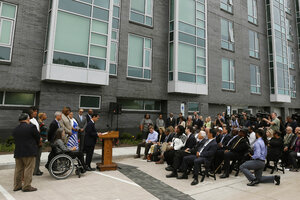Revised federal housing subsidies offer mobility to low-income residents
Following a court ruling in December, housing subsidies will now be allocated based on the average rent of ZIP Codes, not entire metropolitan areas. The change provides greater access to higher-cost neighborhoods, which experts say could help fight segregation.

Former Housing and Urban Development Secretary Julian Castro announces policy changes next to public housing units in Chicago on July 8, 2015. A new federal housing subsidy system will help low-income residents in this city move into more expensive neighborhoods.
Christian Lee/AP/File
Washington
Tiara Moore, a public school bus aide, has been living with her uncle and young daughter in a high-crime, high-poverty part of Chicago – and she's wanted to move.
Her top choice is DuPage County, just outside Chicago and closer to where her mother lives, but moving has not been easy because the size of the housing assistance she receives from the federal government has limited her choices.
It's a dilemma that could be shared by many of the 5 million people receiving assistance, but following a court ruling late last year, the situation is set to change fast.
The ruling mandated the US housing department address this issue by changing how officials calculate low-income housing assistance for the Housing Choice Voucher program, the government's largest such initiative.
The change seeks to reverse a longstanding trend in US cities, increasingly divided between rich and poor: Families receiving housing assistance are concentrated in poor areas that tend to have lower-performing schools, fewer services, and higher crime.
Moreover, in many metropolitan areas, two-thirds or more of Housing Choice Voucher tenants are from ethnic minorities, according to a lawsuit brought by Ms. Moore and two other plaintiffs that prompted the court ruling just before Christmas.
Since implementation of the new rule started on Jan. 1, it has been an "all hands at the pump" situation for housing administrators, said a spokesman for the US Department of Housing and Urban Development (HUD).
"We are moving full steam ahead on implementation of this in the wake of the judge's ruling," said Brian Sullivan with the HUD. "We're doing everything we can to help about 200 public housing agencies get where they need to be."
At issue is the geographic scale used to determine housing subsidies.
For decades, these have been based on average rent prices stretched over entire metropolitan areas, including low prices in small towns and poor neighborhoods and higher prices in richer neighborhoods.
The end result often has been an assistance figure that can help a family rent an apartment in a poorer area but that is insufficient for them to move to a richer area.
"HUD has known for decades that using an average rent level across a metro level tends to reinforce existing patterns of segregation," said Philip Tegeler, executive director of the Poverty & Race Research Action Council, one of five organizations that sued the housing department on behalf of Moore and others.
In Moore's case, that translated into a voucher worth $1,200 a month – inadequate, according to the lawsuit, for her to rent an apartment of the same size in DuPage County.
Now the calculation will no longer be made on the basis of large metropolitan areas but rather by looking at rental costs at a much smaller scale: postal zones, known as ZIP Codes in the US.
Following the December court ruling, this change is being rolled out in 23 metropolitan areas, including Chicago.
For Moore, it means a housing voucher worth an additional $500 or more per month, according to the lawsuit – enough for her to make the move she has wanted. Some lobby groups opposed the rule, known as Small Area Fair Market Rents, adopted – but not implemented nationwide – during the final months of the Obama administration.
The National Association of Home Builders, for instance, in June warned that implementation could result in fewer households receiving assistance as well as a decline in investment in poor neighborhoods.
In August, the Trump administration announced it would delay the rule’s implementation for two years, citing local-level public housing authorities’ need for more time for preparation.
Others say implementation is a major step forward.
"Ultimately the goal is to give families a choice to move to less-segregated areas if that's what they want. This isn’t some social engineering goal: The aim is just to allow people to have that choice," said Mr. Tegeler, calling the change a "very logical step."
There is already some data showing the new approach's efficacy.
The Dallas metropolitan area has been implementing the ZIP-Code-based approach to housing subsidies since 2011, after being ordered to do so by a court. Other urban areas have been doing so as part of a demonstration project run by the federal government.
The Cook County Housing Authority, which oversees public housing outside Chicago, has been using this approach for the past three years and credits it with moving 150 families into more affluent areas.
Cook County is one of the largest counties in the country and includes very rich and very poor communities.
"We do think that this is something that all of the major metro areas should use. It's proven to be the best way to reduce poverty and concentrations of poverty," said Richard Monocchio, the authority’s executive director.
"If you allow people to move into areas that allow more opportunities, you can start to reverse the issues that contribute to generational poverty."
This story was reported by Reuters.

